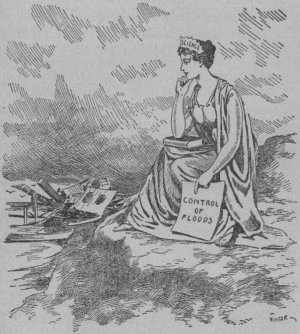FLOODS ON OHIO AND MISSISSIPPI
WATERS FROM NORTH FILL GREAT RIVERS—NAVAL RESERVES AND NATIONAL GUARDSMEN HASTEN TO RESCUE — EARTHQUAKES ARE FELT — NATURE ON A RAMPAGE.
As floods receded in Ohio and Indiana rains came in more southern portions and the volume of water menaced Ohio and Mississippi river towns, many of which were wrecked and ruined the year before by a great flood. Men patrolled levees and governors of states ordered out regiments of national guardsmen and train loads of men with sand bags and shovels hastened to strengthen the earthen walls that held back the floods.
The Ohio river at Cairo, Ill, rose more than 55 feet. The levee is fifty-five feet high, and it is weighted down with sandbags for two feet additional.
Traffic on the interurban road out of river towns was stopped on Sunday. Water swept over the top of the levee at Bird’s Point, Mo., laying waste a large section of southern Missouri.
The number of workmen strengthening the Cairo levees was doubled and the city took every precaution to hold back the flood.
Four companies of the Illinois national guard— those from Mount Vernon, Newton, Sullivan and Olney—were the first to arrive, under command of Colonel Ryman of Effingham. Crowds of refugees from southeastern Missouri arrived in Cairo to add to the stampede.
The Cairo executive flood committee sent an appeal to President Wilson asking for aid for Cairo and towns near by.
The message in substance follows:
"The worst flood ever known in the Ohio valley and the Mississippi is now expected. All previous high water records at Cairo south may be broken in a few days. We are making every effort in our power to take care of local situation, but the river communities near us should have assistance. Boats, sacks, food and other supplies are needed. May we not have the help of your great office for this district or is it necessary to wait until property and possibly lives are lost before aid can be obtained from the Washington government?"
Chicago militiamen were called out on Sunday, March 30, and left for Cairo, Ill. Danger of levees giving way at that point and at Shawneetown, Ill., if the Ohio river rises much higher alarmed the inhabitants and a call to Governor Dunne for troops to keep order resulted in the hasty departure of the "fighting 7th." Part of the regiment left the city about 4 a. m. and the remainder at 11 o’clock.
The Illinois naval reserves left in the morning to help in the southern Illinois city. The 7th was commanded by Col. Daniel Moriarty and the reserves by Capt. E. A. Evers.
Difficulty in assembling the troops at the armory in response to the hurry call delayed the departure and it was nearly 4 a. m. when the first body of guardsmen got away from the city. The men marched from the armory to the Thirty-first street Illinois Central station, where they entrained. Colonel Moriarty and his staff were with the first detachment.
When the telephones began to work, as Captain Morton and some of his aids endeavored to reach the other officers of the regiment it was discovered that many were not at home. Those at the armory kept the wires busy, however, and as rapidly as possible assembled most of the officers and more than half of the regiment. Orders were left for the balance to follow on a special train, and the first detachment wasted no time in getting to its train.
At 10 o’clock Sunday night Colonel Moriarty made arrangements with the Illinois Central railroad for special trains to convey the troops to the southern part of Illinois. Arrangements for the transportation of the baggage also were made and teams were engaged for the moving.
Members of the regiment were scattered from Lake Forest to South Chicago and from the lake to the western city llmits.
Captain Evers of the naval reserves took a thirtyfive foot steam launch, which was carried on a flatcar, and four other launches, powerful vessels well calculated to withstand the force of the flood. Ninety men left with the boats.
Four companies of the Fourth Illinois, nearer the danger point, also were ordered south.
The governor remained in the executive chamber in the capitol in almost constant telephone communication with Chicago as well as with Mayor Parsons of Cairo, Sheriff Fraser of Alexander county and others near the levee.
Never in the history of the country did the elements play such tricks. With stories of flood and fire and tornadoes came reports of earthquakes. Scientific men predicted earthquakes on the day the flood broke and they came a week later.
At Washington, D. C., on March 31, an earthquake of unusual intensity was registered on the seismograph at Georgetown university. The principal tremor occurred at 11:35, although the quakes lasted from 11:01 to 12:30 the next morning. The disturbance, apparently, was between 6,000 and 7,000 miles from Washington.
The seismograph at St. Louis recorded an earthquake of unusual violence on the night of March 30, at a point estimated to be 4,200 miles away. The shock was most severely felt in Behring Straits. It traveled southeast. Six main waves, the first of which was recorded at 9:51 p. m., were followed by three secondary waves, the last of which was recorded at 11:12 p. m. The maximum vibration took place at 10:10 p. m.
 |
Continue
Back
Back to Legacy